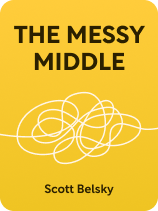

This article is an excerpt from the Shortform book guide to "The Messy Middle" by Scott Belsky. Shortform has the world's best summaries and analyses of books you should be reading.
Like this article? Sign up for a free trial here.
What does it take to maintain focus while leading a growing business? How can you balance structured planning with the need to stay flexible?
Personal growth in business requires mastering several key skills. From developing laser focus and trusting your instincts to making tough decisions and adapting to change, successful leadership demands continuous self-improvement alongside your company’s evolution.
Continue reading to explore the essential leadership capabilities that can help you and your business thrive during crucial growth phases.
Personal Growth in Business
In The Messy Middle, Scott Belsky discusses the importance of personal growth in business, arguing that you have to work to constantly improve yourself as a leader while nursing your startup through its growing pains. In particular, Belsky says to work on your ability to focus, make instinctive decisions, and plan for the future while remaining flexible about the inevitable changes you’re bound to face in this time.
Focus & Flexibility
Belsky writes that, to be successful, you must focus your efforts and say no to distractions. This can be tricky because as your business grows, you’ll encounter more opportunities and have to choose between them. Belsky advises analyzing opportunities based on whether they match up with your goals or will help you develop a skill. By being selective, you don’t waste your time and energy on pursuits that won’t pay off for your business. However, you must also learn to make those decisions without getting bogged down by overthinking—sometimes it’s best to go with your instinct rather than endlessly weighing your options.
Surviving a growing startup’s middle years requires constantly improving your business instincts and decision-making skills. Belsky suggests seeking advice from sources who don’t always agree and using it to refine your intuition. He also emphasizes the value of doubt to equip you to make decisions in the face of uncertainty. Lastly, to make good decisions, you have to maintain your ability to think creatively. Belsky recommends blocking out time to tap into your creativity by turning off all your devices and letting your mind wander. Otherwise, your mind will stay reactive to every phone call and email notification, all of which stifles innovative thinking.
| Perspectives on Focus Belsky references many skills to learn and make use of in relation to staying focused on your business priorities. That’s because the concept of “focus” is very broad. Let’s explore how other experts on productivity and the brain have addressed the topic. One way to define focus is as selective attention. In his book Focus, psychologist Daniel Goleman contrasts open awareness and selective attention as two mental states your brain engages in. Open awareness is fluid, passive attention in which you’re not focusing on one specific task, whereas selective attention is the effortful focus you use to filter through the flood of sensory stimuli and narrow your attention to what is relevant. As Belsky suggests, selective attention is the mode your brain engages in to decide what’s relevant to your current task and what’s a distraction you should try to avoid. Another way to look at focus is as deep work. In his book Deep Work, computer scientist Cal Newport discusses focus as uninterrupted concentration on a task that pushes your cognitive abilities to their limit. Newport explains that skills you need to succeed in the modern economy—like complex problem-solving, data analysis, and computer programming—require deep work to learn and execute. Deep work is also what you’ll have to engage in to improve the business instincts and decision-making skills that Belsky highlights. |
Business success also requires planning—and the willingness to adapt as circumstances change. Belsky suggests you view planning as a thought exercise that prepares you for your business’s unpredictability. However, you shouldn’t expect your business’s growth to follow your original plan. Instead, regularly reevaluate your progress and adjust your plans, letting go of projects and ideas that no longer serve your goals, even if you’ve already put significant resources into them. It’s natural to value a project that you’ve invested time and money into, but clinging to past investments can prevent you from making the changes your business may need so it can flourish.
(Shortform note: In addition to the business situations Belsky describes, flexible planning has long been vital to success in military operations. In Made to Stick, Chip and Dan Heath relate the adage that “no plan of battle survives contact with the enemy.” In business, this means that no business plan survives the real-world market unchanged. The Heath brothers explain that the US Army distills all aspects and details of a plan to a central point—the “commander’s intent” that defines an intended outcome. In a business sense, your intent may be to reduce costs or open new markets, so when you periodically reevaluate your plan, use your overall intent as a guide so you don’t become attached to specific details as to how to achieve it.)
Making Hard Decisions & Taking Responsibility
If you avoid major issues for too long in favor of making small corrections here and there, your business will build up “organizational debt.” Belsky writes that organizational debt is the build-up of hard decisions that leaders avoid, often because of an aversion to conflict. Organizational debt manifests as retaining workers you should let go, maintaining outdated processes, or putting off needed restructuring. To reduce or prevent these problems from occurring, Belsky says to confront your challenges rather than working around them. Make it clear that this duty also falls on your team to identify and eliminate inefficiencies by being honest with themselves and seeking continuous improvement.
(Shortform note: The organizational debt that Belsky warns against is similar to the concept of “technical debt,” a software industry term for issues that designers put off solving in favor of short-term workarounds. Technical debt takes the form of software bugs, wasted resources, and misleading documentation, and incurring it lets developers move ahead on projects that are at least partially working. The assumption many developers make is that they or someone else in the future will resolve the problems they leave unfinished, but left unchecked, technical debt leads to faulty products and disgruntled customers. Organizational debt is arguably worse than technical debt, since it directly affects the company as a whole.)
The larger your business grows, the more likely it is to become bureaucratic, focusing on rules and procedures while slowing down innovation. Belsky advises against blaming bureaucracy, since it’s often needed to keep a big business afloat. Instead, the key to innovation in such environments is to keep projects moving incrementally forward and take responsibility for maintaining momentum. As with reducing organizational debt, this job doesn’t solely fall on the business owner. Belsky suggests that anyone on your team, regardless of their position, can drive progress with the right motivation, which follows from your job to keep all team members invested in achieving your company’s goals.
(Shortform note: The incremental progress that Belsky recommends will surely move you forward, but there is another option—a “design sprint.” In Sprint, Jake Knapp, John Zeratsky, and Braden Kowitz describe the idea as an event in which a team is given one project to delve into for a week, while postponing all other meetings and bureaucratic obligations. A sprint lets your team focus all of its output on a single task, which can jump-start momentum on a particular problem. A design sprint begins by identifying the outcome you want to accomplish, gathering ideas on how to achieve it, and narrowing your team’s focus to a few priorities. At the end of the week, your team will feel a boost from having achieved an important stepping stone.)

———End of Preview———
Like what you just read? Read the rest of the world's best book summary and analysis of Scott Belsky's "The Messy Middle" at Shortform.
Here's what you'll find in our full The Messy Middle summary:
- A gravely overlooked aspect of being an entrepreneur
- The skills you need to keep your startup business afloat
- Why the middle part of starting a business is the most important






